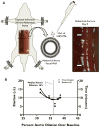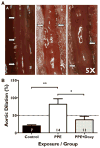Development of a novel murine model of aortic aneurysms using peri-adventitial elastase
- PMID: 22828146
- PMCID: PMC3601193
- DOI: 10.1016/j.surg.2012.02.010
Development of a novel murine model of aortic aneurysms using peri-adventitial elastase
Abstract
Background: Our aim was to establish a novel model of abdominal aortic aneurysms (AAA) in mice using application of peri-adventitial elastase.
Methods: C57BL/6J male mice underwent infrarenal peri-adventitial application of either (1) sodium chloride (control; n = 7), (2) porcine pancreatic elastase (PPE; n = 14), or (3) PPE and doxycycline (PPE + doxycycline 200 mg/kg; n = 11) for 14 days. Aortas were analyzed by video micrometry, immunohistochemistry, qualitative polymerase chain reaction, and zymography. Groups underwent Mann-Whitney U comparisons.
Results: At day 14 compared with baseline, control animals had minimal aortic dilation, whereas fusiform aneurysms were seen in PPE (control, 20 ± 3%; PPE, 82 ± 15%; P ≤ .003). Doxycycline abrogated aneurysm formation (PPE, 82 ± 15%; PPE + doxycycline, 37 ± 10%; P ≤ .03). Compared with control and PPE + doxycycline, immunohistochemistry demonstrated greater elastin fiber degradation, macrophage infiltration, and matrix metalloproteinase-9 expression in PPE. Ki-67 and cleaved caspase-3 were lower in control versus PPE. The loss of smooth muscle marker expression seen with PPE was preserved in PPE + doxycycline. Zymography confirmed that both MMP-2 and -9 were more active in PPE than PPE + doxycycline.
Conclusion: Peri-adventitial application of elastase is a simple, reproducible in vivo model of aneurysm formation leading to consistent infrarenal aortic aneurysm development by day 14, with inflammatory cell infiltration and MMP upregulation. Doxycycline inhibits AAA progression in this model via limiting matrix degradation and preserving differentiated smooth muscle cells.
Copyright © 2012 Mosby, Inc. All rights reserved.
Figures





References
-
- Ailawadi G, Eliason JL, Roelofs KJ, et al. Gender differences in experimental aortic aneurysm formation. Arterioscler Thromb Vasc Biol. 2004;24:2116–22. - PubMed
-
- Ailawadi G, Eliason JL, Upchurch GR., Jr Current concepts in the pathogenesis of abdominal aortic aneurysm. J Vasc Surg. 2003;38:584–8. - PubMed
-
- Daugherty A, Cassis LA. Mouse models of abdominal aortic aneurysms. Arterioscler Thromb Vasc Biol. 2004;24:429–34. - PubMed
Publication types
MeSH terms
Substances
Grants and funding
LinkOut - more resources
Full Text Sources
Research Materials
Miscellaneous

